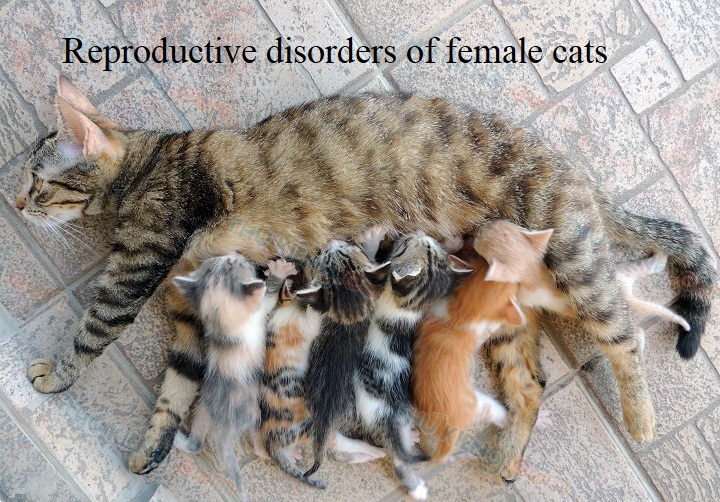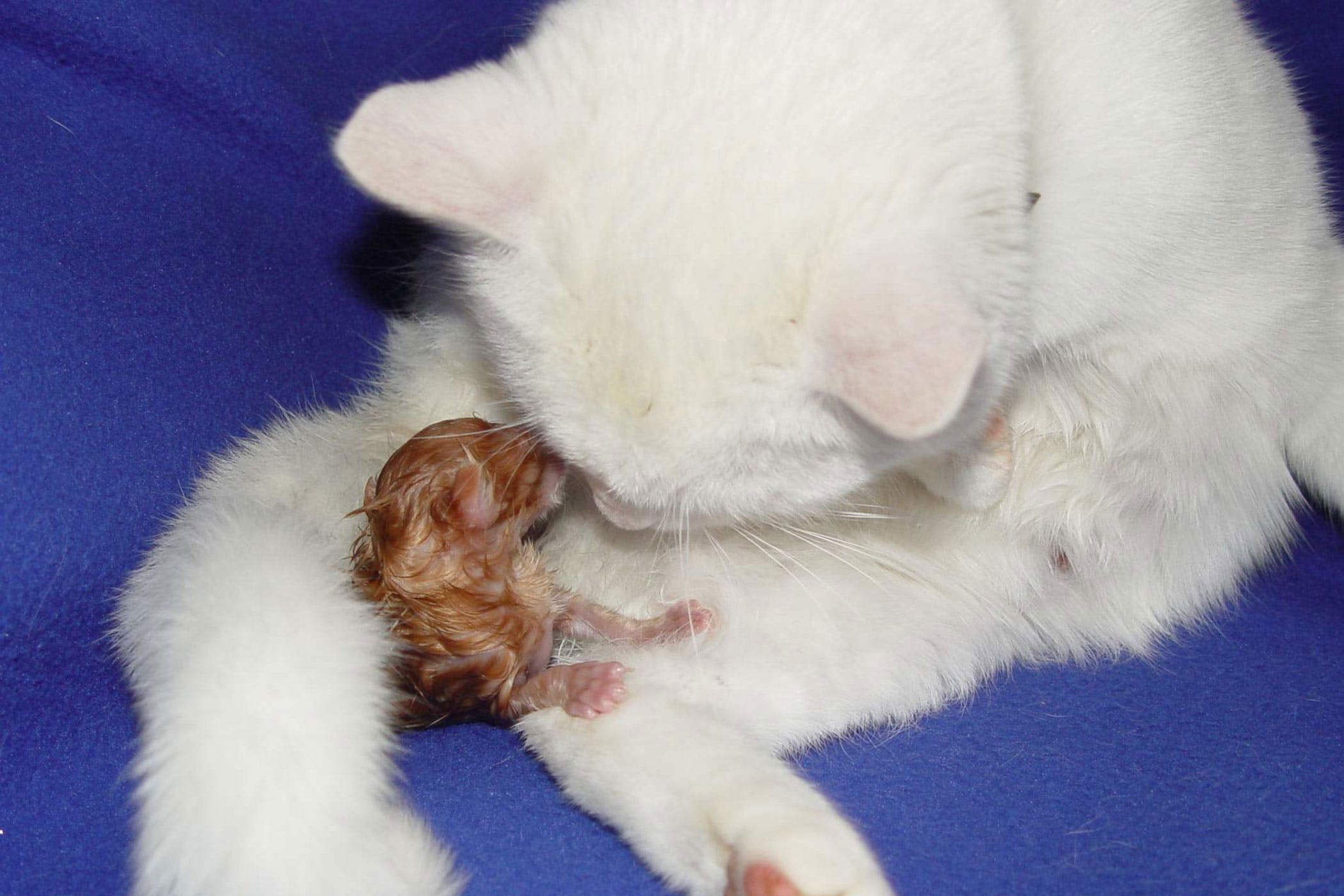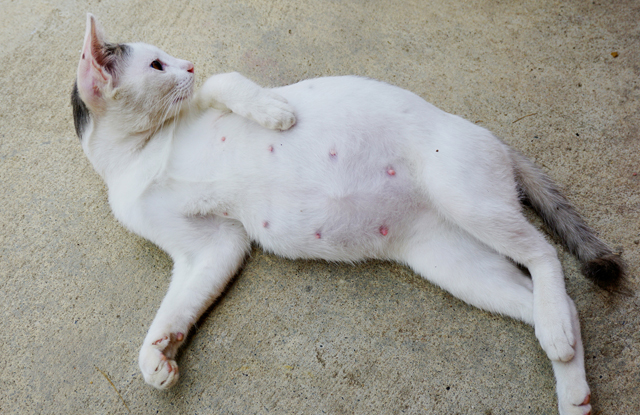Reproductive disorders of female cats

There are many reproductive diseases that can affect the reproduction of female cats. The most common diseases are discussed below.
1. Unusual or difficult delivery (Dystocia)
Many factors can cause a difficult birth (Dystocia), including problems with the uterus, a vagina that is too small, an oversized fetus, or an abnormal position of the fetus during delivery. One of the common situations in cats is that the kittens are partially pointed. Unless the kitten's head is sticking out (so the kitten can breathe), it must be delivered within 10 to 20 minutes or the kitten will die.
• Dysmenorrhea should be considered in any of the following situations:
• The cat has a history of dyskinesia.
• Strong contractions for more than 1 to 2 hours without birth.
• The rest period during labor lasts more than 4 to 6 hours.
• Pain or obvious signs of illness in the mother cat (eg, crying, licking or biting the vulva).
• Abnormal discharge from the vulva area (eg, fresh blood or dark green discharge before the kitten was born).
• Kittens are not born within 24 hours after the rectal temperature drops below 37℃.

Once the cause is identified, the appropriate treatment can be selected. X-rays or ultrasounds can show how many fetuses there are. Medicines can sometimes help progress labor if the mother and kittens are stable and unimpeded. Surgery (cesarean section) is performed if the mother cat or kittens are unstable, there is a problem that makes it impossible to give birth vaginally, labor is prolonged, medications don't work, or the fetus can't deliver naturally. .
2. Pseudopregnancy
False pregnancy (false pregnancy) is uncommon in cats but occurs when they are stimulated to ovulate but do not conceive. There may be growth of the mammary glands with milk production. Cats also often change behavior (e.g., act as if pregnancy and labor have occurred). Your veterinarian will rule out the possibility of a true pregnancy by looking at the pathology, physical examination, and X-rays or ultrasounds. When this occurs, treatment is generally not recommended because the condition usually clears up on its own in 1 to 3 weeks and treatments can have significant side effects. You should not express milk outside the mammary glands, as this will only stimulate more milk production. If your cat has repeated episodes of false pregnancy, neutering will be the way to end the condition.

Overgrowth of mammary gland tissue (mammary gland hypertrophy)
Breast enlargement is a benign condition characterized by rapid abnormal growth of one or more breasts. This disease most commonly occurs in young or pregnant female cats, but can occur in unneutered females of any age and in older cats; in unneutered males and in neutered males following progesterone treatment. This condition is caused by the effects of progesterone and is not cancerous. The most commonly recommended treatment is sterilization (surgical removal of the ovaries and uterus), although remission may occur on its own, sterilization will prevent this from happening again.
3. Endometrial cancer
Ovarian cysts are fluid-filled structures that develop in the ovary and result in prolonged, persistent secretion of estrogen that show signs of estrus and attract males. Ovulation may not occur during this irregular estrous cycle. Any female cat with ovarian cysts should be suspected when she is in heat for more than 21 days. This can sometimes be difficult to distinguish from a regular, normal estrus cycle. This condition is diagnosed through laboratory tests or ultrasound. The most commonly recommended treatment is sterilization (removal of the ovaries and uterus) to possibly cure the disease. If the cat is bred for breeding, the use of medications that affect ovulation can resolve the condition.
4. Metritis
Uterine inflammation is an inflammation of the uterus and can occur after pregnancy. Factors such as a long or difficult delivery and a missed pregnancy or placenta can lead to metritis. This disease is usually a bacterial infection. The main sign of metritis is a discharge of pus from the vulva. Female cats with metritis are often depressed, febrile, and may neglect their offspring. Kittens may become restless and cry incessantly. The infection is diagnosed through a physical exam of the abdomen, X-rays, ultrasound, and lab tests. Treat with intravenous fluids, supportive care, and appropriate antibiotics. Your veterinarian may also prescribe prostaglandin F2α to help remove a retained fetus or placenta. Severely ill cats may need caesarean section once they are stable enough for anesthesia.
5. Pyometra
Pyometra is a bacterial infection of the uterus caused by hormonal changes in cats that have not been spayed. It is less common in cats than in dogs. Signs of change include lethargy, poor appetite, increased thirst and urination, and vomiting. When the cervix is open, there will be pus discharge, often with blood. When the cervix is closed, there is no discharge and the uterus is enlarged which can cause abdominal distention. Symptoms can progress surprisingly quickly and lead to death.
Infection is diagnosed by physical examination, characterization of discharge, abdominal X-ray, ultrasound, laboratory tests, and blood tests. Removal of the ovaries and uterus (sterilization) is the best treatment in most cases. A bacterial infection causes the disease and will not respond until the pus-filled uterine fluid is removed. Before surgery, your cat may need to be stabilized with intravenous fluids and antibiotics. Antibiotics are continued for 7 to 10 days after surgery. Surgery can cure this condition.
Medical treatment may be considered for cats that are bred to continue breeding but are not severely affected and have an open cervix. Drugs used as an alternative to surgery have side effects, including an increased risk of uterine rupture in animals with a closed cervix. These drugs are often administered in veterinary facilities because they can also cause side effects in humans. Of cats that respond to medical treatment, 70% may still be fertile. Recurrence is a common occurrence. These cats should be bred in each subsequent estrus cycle until there is no further desire to breed, and then the cat should be spayed.
6. Inflammation of the mammary gland
Mastitis is inflammation of the breast gland(s) after childbirth. It is not common in cats. Mastitis is usually caused by a bacterial infection. Risk factors for developing mastitis include poor hygiene, trauma caused by the offspring, and systemic infection. Mastitis can involve one or more glands. Milk can be normal or abnormal in color or consistency. Affected milk glands may be hot and painful. If mastitis progresses to a systemic infection, symptoms such as fever, depression, poor appetite, and coma will appear. The mother cat can also neglect her kittens. In cats with long-term infections, the only possible sign is that the kittens are not growing.
The disease is diagnosed based on the cat's medical history, physical examination, and assessment of milk production from each mammary gland. Mastitis can be treated with appropriate antibiotics. Cats who are dehydrated or in shock may need intravenous fluids. A warm compress can be applied to the affected mammary glands 4 to 6 times per day and the kittens should be encouraged to suckle from these glands. If the mammary gland develops into an abscess (a sac filled with pus and infection), your veterinarian will likely need to perform surgery.
Non-bacterial mastitis can occur when kittens begin to eat solid food. The affected glands will be hot, swollen, and painful to the touch, but the mother cat will remain alert and healthy. Warm compresses can be applied to the area 4 to 6 times per day. Reducing the mother's food intake to pre-pregnancy levels can help reduce milk production. You also need to provide extra water and food for the kittens.
7. Ovarian Remnant Syndrome
Residual ovary syndrome is caused by residual ovarian tissue in a neutered cat. Affected cats will continue to cycle in heat with variable intervals after surgery. This is a complication of surgery. To diagnose this disorder, your veterinarian should examine your cat when it shows signs of heat. Laboratory tests can confirm the diagnosis. The remaining ovarian tissue must be surgically removed.
- Can cat drink milk? And what kind of milk can cats drink?
- Instructions on how to take care of kittens through each specific stage
- Cats Have Fungus Skin And How To Treat It At Home
- Introducing the cat British Longhair and how to raise Boss
- Cat with Kidney Failure – Can it be diagnosed and treated at home?